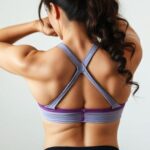Build strength and definition using these 11 powerful Shoulder Workouts. Suitable for any fitness level—sculpt shoulders in no time!
1. Barbell Overhead Press
This barbell overhead press is one of the most foundational compound movements; it trains your full shoulder complex, especially the anterior deltoid, and involves triceps and upper chest as well. It’s best performed when in a standing position as it increases core stability and overall strength.
How to Perform:
Stand at shoulder-width apart. Hold a barbell at shoulder level with your palms facing forward.
Press the barbell overhead until your arms are fully extended.
Lower the barbell back to shoulder level with control.
Pro tip: Keep your core throughout the movement to avoid a big arch of the lower back.
2. Dumbbell Lateral Raise
This isolation exercise specifically hits the lateral deltoids, which create broader shoulders and an improvement in shoulder width.
How to Perform:
Stand upright, holding a dumbbell in either hand at your sides.
With a slight bend in the elbows, raise your arms out to the sides until they reach shoulder height.
Lower the dumbbells back to the starting position with control.
Pro Tip: Use lighter weights to have your proper form while concentrating on muscle use instead of momentum.
3. Arnold Press
This is the shoulder press variation incorporated with rotational movement and is named after Arnold Schwarzenegger, who does an Arnold press.
How to Perform:
Sit on a bench that has back support, carrying dumbbells in front of you at shoulder height with palms facing you.
While you’re pressing dumbbells overhead, rotate your palms to face forward.
And reverse the motion to the original posture.
Pro Tip: Perform the movement slowly to maximize muscle engagement and control.
4. Seated Dumbbell Rear Delt Fly
It isolates and strengthens the posterior deltoids, which are always neglected but much important for shoulder balanced development and posture.
How to Perform:
Sit on the edge of a bench, holding dumbbells with arms hanging down.
Raise the dumbbells to the sides with a slight bend in the elbows until they are level with your shoulders.
Lower them back down again.
Pro Tip: Focus on squeezing the shoulder blades at the top of the movement.
5. Push Press
The push press is best at using a slight leg drive to help an overhead press so that it can lift more weight and develop more explosive power.
How to Perform:
Stand shoulder-width apart, barbell in front position, at shoulder level.
Dip the knees slightly before developing them explosively while pressing the bar overhead.
Lower the barbell back to shoulder height with control.
Pro Tip: Maintain the fluidity of the movement, coordinate the leg drive with the press for maximum efficiency.
6. Face Pull
Face pulls work the rear deltoids and upper back muscles for healthier shoulders and better posture while pulling the shoulder blades down and back.
How to Perform:
This is going to be in touch with the training methodology, with a pause by holding a rope attached to a high pulley.
Pulling the rope towards the face and keeping elbows high and flared out to the sides.
Hold your shoulder blades together at the end of the movement.
Pro tip: Use moderate weights to maintain focus on form and muscle activation without being reckless with loading.
7. Dumbbell Front Raise
To develop the anterior shoulder portions, it is also isolated to better shape the shoulders in front.
How to Perform:
Stand with straight legs, see that your arms are straight, and the dumbbells are in front of the thighs with palms facing your body.
Raise dumbbells straight in front of you to shoulder height.
Lower them back down with control.
Pro tip: Don’t swing but control to maximize the way muscles are targeted.
8. Upright Row
The upright row is directed towards the lateral deltoids and the upper trapezius, working on the shoulder and upper back development.
How to Perform:
Hold a barbell or dumbbells in front of you with palms facing your body.
Lift the weights straight up to chest level, keeping them close to your body.
Lower the weights back down with control.
Pro Tip: Keep elbows higher than the wrists throughout the movement to properly engage the shoulder muscles.
9. Z Press
Z press performed seated on the floor takes away the lower body assistance to the predominant core and shoulder strength.
How to Perform:
Get seated on the ground with legs stretched forward. You should hold a barbell or dumbbells to shoulder level.
Now, press the weights vertically to give the arms complete extension.
Controlly bring the weights back down to shoulder level.
Pro Tip: Ensure to keep a straight posture and core tight so you do not lean back in here.
10. Landmine Press
Landmine press is one of those shoulder-friendly alternatives in pressing as it usually retains a pattern-integrated movement for lessened stress and pressure on joints.
How To Perform:
On one end, secure a barbell on the landmine attachment or in a corner.
With a one-handed grip, hold the other end at shoulder height.
Extend or press the barbell upward and somewhat forward until you straighten your arm.
Lower to the starting position with control.
Pro Tip: Keep your torso upright and avoid leaning into the movement to maintain proper form.
11. Pike Push-Up
A pike push-up is a bodyweight exercise, i.e., the type of exercise targeting the shoulders, anterior deltoids, and others too. This can be done anywhere.
How to perform:
Stand in a downward dog position with the hips raised high in the air and hands somewhat shoulder-width apart.
From there, lower your head toward the ground by bending your elbows.
Push back to the starting position.
Pro Tip: Maintain a tight core and focus on the shoulder muscles to execute this movement.
Simple Shoulder Workout Routine:
Warm-Up:
Arm Circles: 2 sets, 15 reps forward/backward.
Resistance Band Pull-Aparts: 2 sets of 15 reps.
Workout:
Barbell Press from Behind Head: 4 sets of 6-8 reps.
Dumbbell Raise to the Side: 3 sets of 12-15 reps.
Arnold Press: 3 sets of 10-12 reps.
Dumbbell Rear Delt Fly while Sitting: 3 sets of 12-15 reps.
Face Pull: 3 sets of 15-20 reps.
Cool-Down
Stretching: 30 seconds each arm.
Cross-Body Shoulder Stretch: 30 seconds for each arm.
FAQs
1. How frequently should I work on my shoulders?
It’s your call whether to train them once or make it a twice-weekly routine; depending on the regimen, subject it to at least a 48-hour recovery between training sessions to facilitate muscle-building and avoid overstress.
2. Can a single workout address all three heads of the deltoid?
Essentially, a three-part regimen would address all aspects of the deltoid through anterior(most likely known as front), lateral(side,) and posterior (the back) exercises. Examples are anterior with front raises, lateral with lateral raises, and posterior with rear delt flyes.
3. Which is better, compound or isolation exercise for the shoulders?
Both are important. Compound exercises like overhead press build overall strength while isolation exercises refine definition and symmetry, like lateral raises.
4. Can I develop very strong shoulders just using my body weight?
To some extent, yes. Exercises like pike push-ups and handstand push-ups can build serious shoulder strength. However, adding weight (dumbbells or barbells) can optimize hypertrophy and progression.
5. Why are my shoulders failing to achieve optimum growth?
Poor training habits, such as lack of progressive overload, poor form, lack of isolation work, not eating enough, or insufficient rest, are all common reasons. Check your entire program against the list of concerns.
6. Should I train my shoulders with a push day or separately?
Shoulders can be included in a push day (chest and triceps) or a special shoulder workout. This depends on your split training and your goals.
7. What can I do to prevent injuries to my shoulders?
Be sure to warm up properly, perform rotator cuff strengthening exercises (such as face pulls), practice good form, and don’t lift weights that are beyond your control.
8. Will training the shoulders lead to an improvement in posture?
Yes, in particular, exercises promoting the development of the rear deltoids and upper back (such as face pulls, rear delt flys) can assist in reversing that forward shoulder posture brought about by sitting and other bad habits.
















